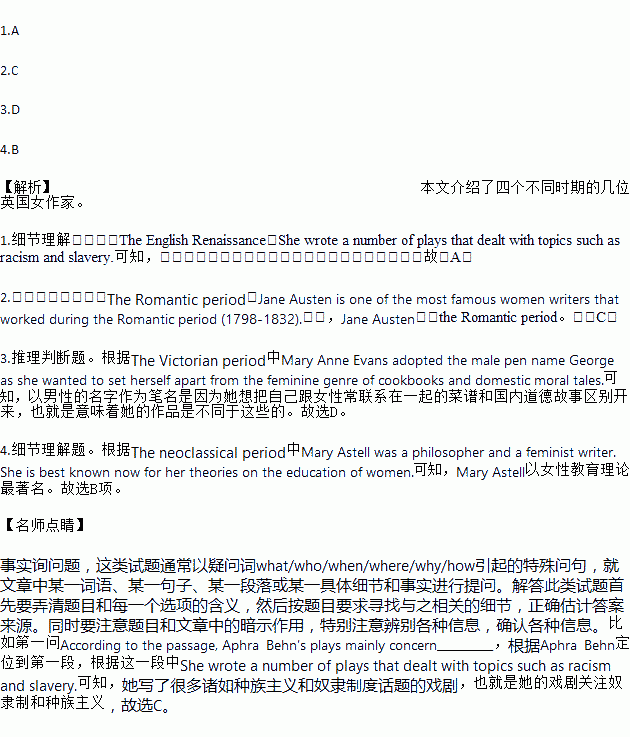题目内容
British Women Writers in different periods of time
The English Renaissance
The English Renaissance began in the later part of the fifteenth century and lasted until the 1660s. Among the most famous women writers of this period is Aphra Behn, who is seen as the first professional woman writer in English. She wrote a number of plays that dealt with topics such as racism and slavery. A good example is Oroonoko published in 1688. Aphra Behn's works include also the plays The Amourous Prince, The Town Fop, The Dutch Lover and her only tragedy, Abdelazer.
The neoclassical period
Among the well-known women in British literature during the neoclassical period, from 1660 to the end of the eighteenth century, is Anne Finch. She wrote poetry and tried to express all that she saw and experienced. Two other women are recognized for their contribution to neoclassical British literature: Mary Astell and Lady Mary Wortley Montagu. Mary Astell was a philosopher and a feminist writer. She is best known now for her theories on the education of women.
The Romantic period
Jane Austen is one of the most famous women writers that worked during the Romantic period (1798-1832). Her works include several novels, most of which focus on marriage as a way for young women to secure social standing and economic security. Her most famous novels are Pride and Prejudice, Sense and Sensibility and Emma. Another famous woman writer from the English Romanticism is Mary Shelley. She is the author of Frankenstein, History of Six Weeks Tour and The Last Man.
The Victorian period
The Victorian period, between the 1830s and 1900, was the time when the Bronte sisters, George Eliot and Elizabeth Gaskell lived and wrote. Charlotte Bronte, Emily Bronte and Anne Bronte produced many British literary classics. Charlotte's novels include Jane Eyre, Shirley, Villette and The Professor. Mary Anne Evans adopted the male pen name George as she wanted to set herself apart from the feminine genre of cookbooks and domestic moral tales. Her most famous novel is The Mill on the Floss published in 1860.
1.According to the passage, Aphra Behn’s plays mainly concern ________.
A. racism and slavery B. economic security
C. education of women D. cooking and gardening
2.Which period does Jane Austen belong to?
A. the English Renaissance. B. the Neoclassical Period.
C. the Romantic period. D. the Victorian period.
3.Why did Mary Anne Evans publish her stories under the name of George Eliot?
A. Women were forbidden to write novels then.
B. It helped promote her works.
C. It sounded more popular.
D. Her works would be different.
4.If a reader is interested in women’s education, whose works can be the best choice?
A. Anne Finch’s. B. Mary Astell’s.
C. Mary Wortley Montagu’s. D. Mary Shelley’s.

